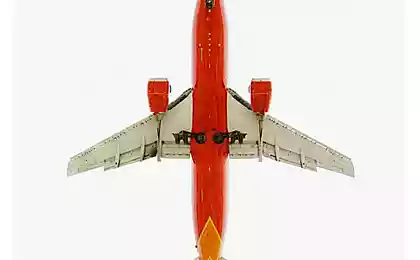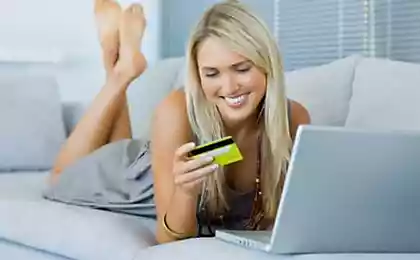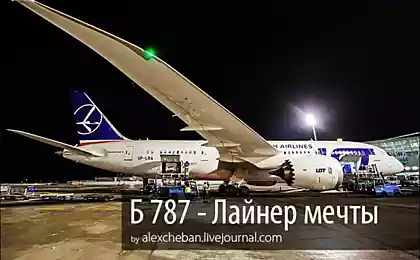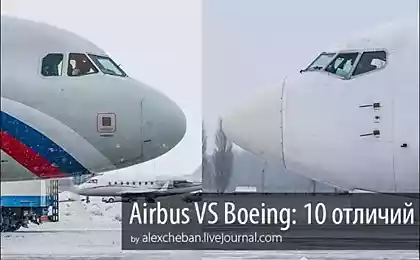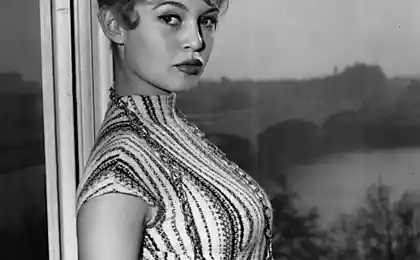2745
Cabin Boeing 737 Classic (28 photos)
Boeing-737 aircraft - the most popular neshirokofyuzelyazhnye main planes in the world.
According to September 2009, Boeing-737 aircraft sold was already 6170.
These aircraft are divided into three generations: Original («Original" - modification of -100, -200), Classic («Classic» -300, -400, -500) and the New Generation («New Generation" -600, -700, -800, -900).
The family of Boeing-737 Classic - this model 737-300, -400 and -500, which differ slightly - mainly long and passenger capacity.
The first aircraft was delivered -300 series in 1984, and the last, -500, - in 1999.
It seems that it is due to almost two thousand aircraft produced series Classic, the former is much more reliable and secure than the Original, Boeing-737 and became a bestseller.
Cab 737 will be considered by the example of our company available in 737-500.
Looks like it is, of course, is much more modest than the Airbus 320.
General view of the cockpit:

As can be seen, compared to nedosamolёtom A320 :), then even have steering wheels.
Certainly, Boeing - it's a real plane.
For real men who are able to compete with the technique.
Left of the steering wheel KBC is another WHEEL - is to control the rotation of the front legs at large angles during taxiing.
You can immediately look at the main wheel:

On his horns:
from the inside - the numerator, which is usually set flight number (so that the pilot had not forgotten during the negotiations with the controllers),
externally:
dual pressure switch electric rudder stabilizer,
autopilot disconnect button,
Microphone switching rocker having two positions - one in a microphone connected to the transceiver for transmission in the other - for internal transmission link (or ground personnel). This switch is on the side of the dashboard and is not visible,
middle - pin for fixing all sorts of useful leaflets, for example, of the approach lane and missed.
By the way, it should be noted that the steering wheel still obscures some devices.
At the helm, the front, the dashboard is a primary flight instruments:
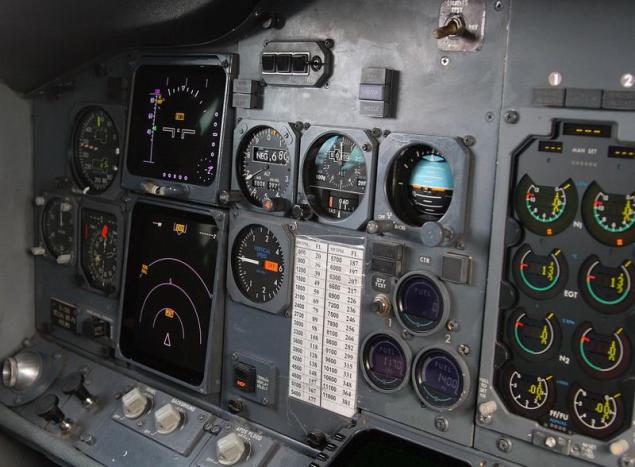
Since the classic aircraft, the instruments and he in many ways - the classic arrow "alarm».
On the left edge of three pieces:
clock, airspeed indicator, radio compass.
Next are two displays:

Upper - replacing the artificial horizon (now simply deactivated inertsialki and therefore no pictures).
On the left there is also a strip of speed, right and bottom - point to indicate deviations from the glide path
and bottom right - altimeter indication.
At the bottom (navigation) display flight plan, the mark of the aircraft TCAS, from the radar picture and something else.
Further to the left:

top left - I do not remember that :), top right - three indicators flight beacons (landing).
Then below from left to right:
barometric altimeter, altimeter replacement with an airspeed indicator, spare (standby) attitude indicator.
Vario (vertical speed indicator), plate matching foot echelons meter (not supplied as standard),
Fuel gauge indicator on the tanks (two in the middle wing and center).
The same dashboard also have a co-pilot.
Between the boards - the central board:

There is already a noticeable incipient transition to an electronic display readings. But until then, "alarm" is replaced only LEDs.
At the very top - Indicator Yaw damper (this yaw damper - to suppress the self-oscillating movement of the aircraft on the course).
Below - the various warning lights.
More below, the left side - Indication of engines:
fan speed (N1),
gas temperature (EGT),
a high pressure compressor speed motors (N2),
fuel consumption.
Panel in the center (top to bottom):
Outside air temperature,
engine oil pressure,
oil temperature and the amount (in percentage),
rotor vibration,
pressure in hydraulic systems A and B; amount of liquid in them (as a percentage).
Right-hand side:
indicator flap (two arrows - for left and right flaps),
switch and indicator antiyuzovoy automatic brake main wheels,
intensity switch automatic braking during landing (RTO - Rejected takeoff).
And more to the right, closer to the second pilot, sticking brutal handle release-retraction.

Hydraulic crane - not your ho-ho.
The bottom of the handle has a clamp (red) to overcome the mechanical locking handle (if necessary).
Mechanical cable runs emergency landing gear (in the absence of pressure in hydraulic systems) ends handles located in the hatches in the floor at the entrance to the cockpit (with their side of the door :)).
Below the center of the dashboard are two MCDU (MFDs) to enter the route of flight.
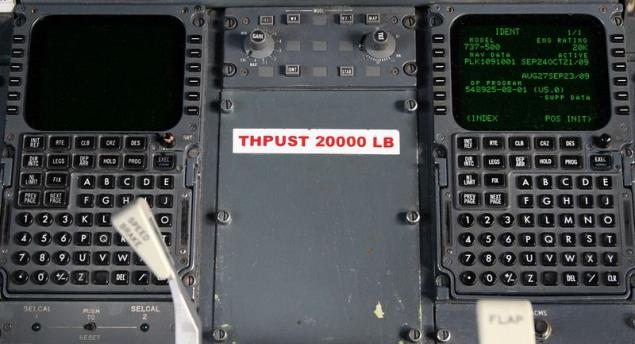
Also, they are tested by some systems, but since the aircraft is much less electrons than A320, and then immediately MCDU functionality is much lower. For example, the mechanics we have them on the 737 is practically used (only experts in avionics sometimes), whereas A320 without this machine - almost anywhere.
In the middle, between them, - the control panel weather radar.
Nakleechka below informs drivers that on this plane engines configured for improved traction - approximately 9 tons each.
Even further back towards the center console is everything to us:
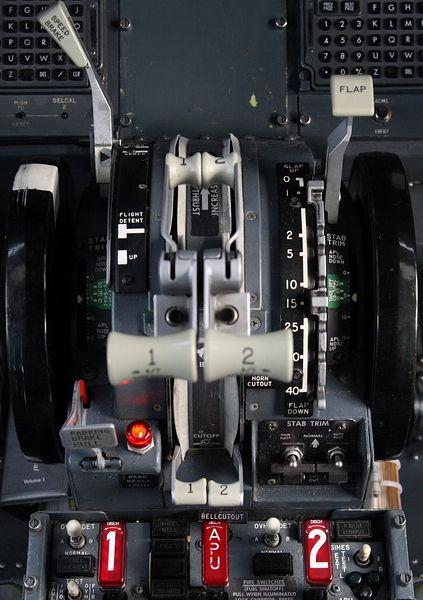
Here are the engine control, high-lift devices, fire alarms and more vsyakostey.
All you can pull (and something even the rides), and all associated specifically with steel cables with different parts of the aircraft.
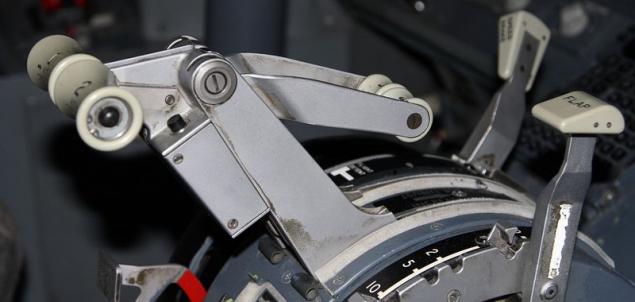
Bottom left sticking lock the parking brake,
right and above - two Ore (engine control levers, or rather, their thrust) with RURami them in front (reverse levers). Button on the end of ORE disables autothrottle, and the button sticking up - includes the maximum mode both engines for the missed approach or take-off as quickly as possible.
Right and continue sticking Handle spoilers (air brakes),
rightmost and closer - Handle flaps.
Below on the same console on both sides have drums associated with the control cables relaying stabilizer:
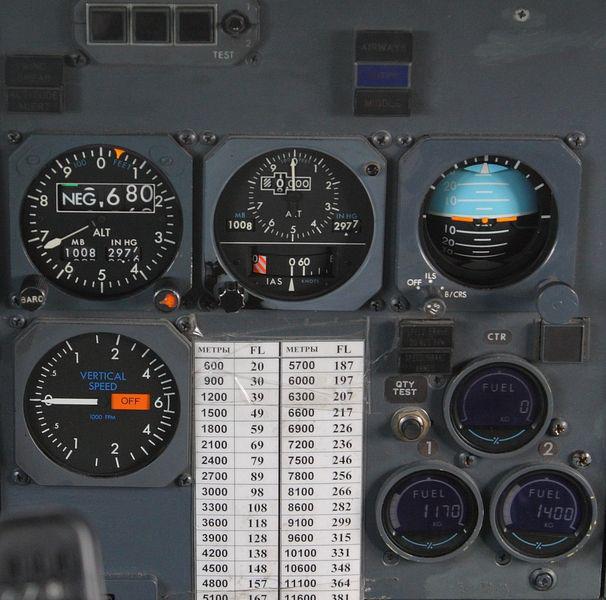
The drums have a retractable handle for manual stabilizer rudder in case of failure of the electric control.
Visible to the left toggle off the automatic stabilizer trim control.
Panel fire protection system:

Two handles for engines (on the sides) and one for the APU (center).
When pulling up the appropriate motor is de-energized, the power is cut off fuel and hydraulic fluid.
To discharge a fire bottle, turn the knob to the side.
Toggle switches - to test parts of the system.
The center console.
From front to back.

On the left side (it is the middle panel):
top - the camera screen monitor the doorway space in the cockpit. Since there are no tables at Boeing, just on the screen is very convenient to put all the little things because of what he and shabby.
below - extinguishing system control panel trunk.
More below - control of aircraft collision avoidance system TCAS.
Now right-hand side:
top - remote control VHF radio,
below - radio navigation control.
More below - the control panel display of information on the navigation display and height adjustment autopilot disconnect.
Left panel, from the FAC, is completely analogous to that shown, the right panel of the second pilot.
Further, the central control (over backward flight):
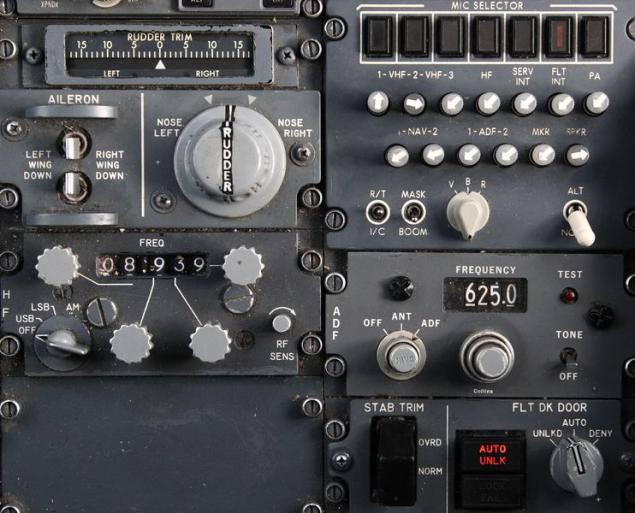
Left part:
top - control trim and roll rate,
below - the control panel HF radio.
Right-hand side:
panel audio devices (radio service communication with the flight attendants, ground crew communicate with, ...)
below - the panel frequency setting ADF ... It's ... uh ... automatically nahoditel direction :)) in translation.
at the bottom - control electric door lock cockpit.
Actually, on this plane too much allows the second pilot :)
he and control door lock has a close and tap oxygen near it is, so that he can pull the plug KVSU literally :)
Airbus on this do not can - there and oxygen closer to the captain, and the door lock, too.
The most delicious, as usual - ceiling panel :)

From here they (designers) and pulled on the part protruding toggle switches, switches and buttons :)
In the bottom of the panel is controlling the external light:

From left to right:
landing outside (on the wing) and internal lights,
lamps lighting taxiing sideways,
rulёzhnaya lamp on the front foot,
start switch on and off the APU,
ENGINE START switch and select the mode of operation of the ignition system,
strobes, navigation lights, flashing beacons, lights wing, landing gear lights.
Below - a spare magnetic compass:

The lower left part of the ceiling panel:

top left - the index of temperature of the fuel in the left wing tank,
on either side of him - position lamp fuel valves (can not remember what. Probably the motor).
below - Crane ringing fuel supply system of the left and right engines.
below - switches the fuel pump tanks (two for each tank).
From left tank pump also feeds the APU, so it is usually left rear tank pump is always on.
Bottom right:
LED gas temperature at the outlet APU APU generator and an ammeter.
above - breakers contactors connect to the network of generators engines, APU generator power source and ground.
above - ammeters electric generators engines.
AC system on the plane 115, 400 Hz.
Above this panel:
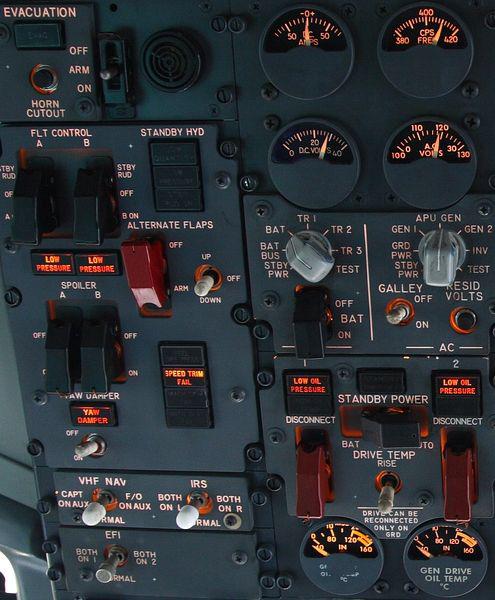
From top to bottom left-hand side:
evacuation signal,
control panel connecting a spare hydraulic powered alternative control flaps, rudder, spoilers. Enabling yaw damper.
navigation and control of switching the display on the trouble-inertial navigation system in case of failure of the second,
Switching something else to be in good :)
From top to bottom right-hand side:
ammeter DC (battery) and voltmeter, frequency generator and APU AC voltmeter,
switches voltmeters DC and AC current, battery switch, power switch kitchen equipment,
Connections control panel backup AC power supply,
there - toggle mechanical disconnection generator shafts AC motors from the motor drive units boxes,
oil temperature constant speed motor drives
(The fact that the rotor of the motor rotates at different frequencies depending on the operating mode and the frequency of the voltage electrical generators engines must be constant).
And in fact, the very top of the ceiling - the backup position indicator slats:

Now - the right side of the top of the ceiling (even above the ceiling panel):

Left - the control panel inertial navigation systems (of which there are two).
right: top - toggle switching service points due to the cabin (many of them on the plane - near the APU compartment near the engine somewhere else ...), below - the toggle switch on the light cabin;
More to the right: at the top - the third panel audio devices occupier,
under it - the power button electronic engine blocks,
below - electronic pressure gauge in the oxygen tank crew and passengers toggle ejection masks,
under them - duplicate landing gear position indicator plate and the minimum pressure of oxygen in the vehicle-cylinder depending on the number of crew members in the cockpit.
rightmost part:
The emergency recorder
test button and warning systems, overspeed and stall.
The upper right part of the ceiling panel:

Left: the window lamp illumination central control, dimming illumination panels filling stations and ceiling panel.
right: top panel heating sensor static and dynamic pressure, as well as cockpit windows; below - control anti-icing system of engines and wings (they are all air).
right-hand side - control air conditioning in the cabin and in the cockpit (they work partially mixed, but left pack more runs on the cockpit and the right - mostly on the interior, so the plane on the ground is heated and cooled often puck right). Top - position indicators dampers mixing hot and cold air between them - the temperature indicator switch to the "supply line" and "salon"; below - the temperature indicator, even lower - two setpoint temperature (now stand in a position of direct manual control valves, and most of the arc of a circle - set the temperature in the cabin for its automatic maintenance).
Panel underneath:

Left:
top - the choice of normal or alternative avionics cooling fans (ie, electronic equipment),
below - operation of hazard warning lights in the cabin,
More below - Paddle boards include salon "No smoking" and "Fasten your seat belts».
right:
top - indicator lamps insufficient pressure hydraulic fluid in hydraulic and toggle their inclusion electric pumps and valves opening to the motor hydraulic pumps;
below - MIL open doors and hatches;
below - the control panel voice cockpit recorder (microphone - the left under the mesh).
the right-most part - control air conditioning packs (gauge pressure indication in the lines, toggle the fan air recirculation, toggle valves in the air again and the selection of engines and APU (bottom middle). Indicator lights).
The lowest and the most right side of the ceiling panel:
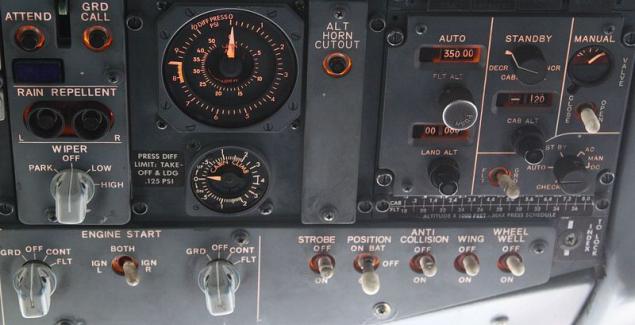
Left:
top - flight attendant call signal and ground personnel;
sprinkling system water-repellent windshield fluid (now deactivated on all types of aircraft),
below - including wiper copilot.
the lowermost part of the panel have already explained earlier.
middle - indicators "height in the cockpit" and its rate of change, mute button buzzer;
the rightmost part of - control system maintain the air pressure inside the aircraft (on the left side - automatic mode, the middle - a spare, right - hand control valve exhaust air from the cabin; bottom right - mode control system).
And now there was only one small thing - all sorts of stuff.
In the bottom right of the picture - the handle adjust the distance to the pedals:

(This is - just under the dashboard of the corresponding pilot)
Pilot's seat (riveted sheet of this real metal rivets)

Leverage in the most unexpected places, continuity design with military transporters and, simultaneously, with the B-777. I think, on the B-787 will be the same riveted steel chair :)
On the left side, Krasnenkoe - oxygen mask copilot.
Next - microphone frightening passengers (and other communications can lead).
Emergency Flashlight.
Above it stretches to the pane of glass panes electric heating cable.
Rear pilots - AZSov panel (automatic fuses):

Fire extinguisher.
And finally, just above the pilots:

top left blackens kusochek ceiling panel, below - speakerphone speaker (can broadcast the same as in the headphones),
right, up, - opening the lamp illuminating the upper part of the gas station, under it - the hatch for the emergency rope descents from the vents in which case,
the right of all - the lattice of the ventilation system.
According to September 2009, Boeing-737 aircraft sold was already 6170.
These aircraft are divided into three generations: Original («Original" - modification of -100, -200), Classic («Classic» -300, -400, -500) and the New Generation («New Generation" -600, -700, -800, -900).
The family of Boeing-737 Classic - this model 737-300, -400 and -500, which differ slightly - mainly long and passenger capacity.
The first aircraft was delivered -300 series in 1984, and the last, -500, - in 1999.
It seems that it is due to almost two thousand aircraft produced series Classic, the former is much more reliable and secure than the Original, Boeing-737 and became a bestseller.
Cab 737 will be considered by the example of our company available in 737-500.
Looks like it is, of course, is much more modest than the Airbus 320.
General view of the cockpit:

As can be seen, compared to nedosamolёtom A320 :), then even have steering wheels.
Certainly, Boeing - it's a real plane.
For real men who are able to compete with the technique.
Left of the steering wheel KBC is another WHEEL - is to control the rotation of the front legs at large angles during taxiing.
You can immediately look at the main wheel:

On his horns:
from the inside - the numerator, which is usually set flight number (so that the pilot had not forgotten during the negotiations with the controllers),
externally:
dual pressure switch electric rudder stabilizer,
autopilot disconnect button,
Microphone switching rocker having two positions - one in a microphone connected to the transceiver for transmission in the other - for internal transmission link (or ground personnel). This switch is on the side of the dashboard and is not visible,
middle - pin for fixing all sorts of useful leaflets, for example, of the approach lane and missed.
By the way, it should be noted that the steering wheel still obscures some devices.
At the helm, the front, the dashboard is a primary flight instruments:

Since the classic aircraft, the instruments and he in many ways - the classic arrow "alarm».
On the left edge of three pieces:
clock, airspeed indicator, radio compass.
Next are two displays:

Upper - replacing the artificial horizon (now simply deactivated inertsialki and therefore no pictures).
On the left there is also a strip of speed, right and bottom - point to indicate deviations from the glide path
and bottom right - altimeter indication.
At the bottom (navigation) display flight plan, the mark of the aircraft TCAS, from the radar picture and something else.
Further to the left:

top left - I do not remember that :), top right - three indicators flight beacons (landing).
Then below from left to right:
barometric altimeter, altimeter replacement with an airspeed indicator, spare (standby) attitude indicator.
Vario (vertical speed indicator), plate matching foot echelons meter (not supplied as standard),
Fuel gauge indicator on the tanks (two in the middle wing and center).
The same dashboard also have a co-pilot.
Between the boards - the central board:

There is already a noticeable incipient transition to an electronic display readings. But until then, "alarm" is replaced only LEDs.
At the very top - Indicator Yaw damper (this yaw damper - to suppress the self-oscillating movement of the aircraft on the course).
Below - the various warning lights.
More below, the left side - Indication of engines:
fan speed (N1),
gas temperature (EGT),
a high pressure compressor speed motors (N2),
fuel consumption.
Panel in the center (top to bottom):
Outside air temperature,
engine oil pressure,
oil temperature and the amount (in percentage),
rotor vibration,
pressure in hydraulic systems A and B; amount of liquid in them (as a percentage).
Right-hand side:
indicator flap (two arrows - for left and right flaps),
switch and indicator antiyuzovoy automatic brake main wheels,
intensity switch automatic braking during landing (RTO - Rejected takeoff).
And more to the right, closer to the second pilot, sticking brutal handle release-retraction.

Hydraulic crane - not your ho-ho.
The bottom of the handle has a clamp (red) to overcome the mechanical locking handle (if necessary).
Mechanical cable runs emergency landing gear (in the absence of pressure in hydraulic systems) ends handles located in the hatches in the floor at the entrance to the cockpit (with their side of the door :)).
Below the center of the dashboard are two MCDU (MFDs) to enter the route of flight.

Also, they are tested by some systems, but since the aircraft is much less electrons than A320, and then immediately MCDU functionality is much lower. For example, the mechanics we have them on the 737 is practically used (only experts in avionics sometimes), whereas A320 without this machine - almost anywhere.
In the middle, between them, - the control panel weather radar.
Nakleechka below informs drivers that on this plane engines configured for improved traction - approximately 9 tons each.
Even further back towards the center console is everything to us:

Here are the engine control, high-lift devices, fire alarms and more vsyakostey.
All you can pull (and something even the rides), and all associated specifically with steel cables with different parts of the aircraft.

Bottom left sticking lock the parking brake,
right and above - two Ore (engine control levers, or rather, their thrust) with RURami them in front (reverse levers). Button on the end of ORE disables autothrottle, and the button sticking up - includes the maximum mode both engines for the missed approach or take-off as quickly as possible.
Right and continue sticking Handle spoilers (air brakes),
rightmost and closer - Handle flaps.
Below on the same console on both sides have drums associated with the control cables relaying stabilizer:

The drums have a retractable handle for manual stabilizer rudder in case of failure of the electric control.
Visible to the left toggle off the automatic stabilizer trim control.
Panel fire protection system:

Two handles for engines (on the sides) and one for the APU (center).
When pulling up the appropriate motor is de-energized, the power is cut off fuel and hydraulic fluid.
To discharge a fire bottle, turn the knob to the side.
Toggle switches - to test parts of the system.
The center console.
From front to back.

On the left side (it is the middle panel):
top - the camera screen monitor the doorway space in the cockpit. Since there are no tables at Boeing, just on the screen is very convenient to put all the little things because of what he and shabby.
below - extinguishing system control panel trunk.
More below - control of aircraft collision avoidance system TCAS.
Now right-hand side:
top - remote control VHF radio,
below - radio navigation control.
More below - the control panel display of information on the navigation display and height adjustment autopilot disconnect.
Left panel, from the FAC, is completely analogous to that shown, the right panel of the second pilot.
Further, the central control (over backward flight):

Left part:
top - control trim and roll rate,
below - the control panel HF radio.
Right-hand side:
panel audio devices (radio service communication with the flight attendants, ground crew communicate with, ...)
below - the panel frequency setting ADF ... It's ... uh ... automatically nahoditel direction :)) in translation.
at the bottom - control electric door lock cockpit.
Actually, on this plane too much allows the second pilot :)
he and control door lock has a close and tap oxygen near it is, so that he can pull the plug KVSU literally :)
Airbus on this do not can - there and oxygen closer to the captain, and the door lock, too.
The most delicious, as usual - ceiling panel :)

From here they (designers) and pulled on the part protruding toggle switches, switches and buttons :)
In the bottom of the panel is controlling the external light:

From left to right:
landing outside (on the wing) and internal lights,
lamps lighting taxiing sideways,
rulёzhnaya lamp on the front foot,
start switch on and off the APU,
ENGINE START switch and select the mode of operation of the ignition system,
strobes, navigation lights, flashing beacons, lights wing, landing gear lights.
Below - a spare magnetic compass:

The lower left part of the ceiling panel:

top left - the index of temperature of the fuel in the left wing tank,
on either side of him - position lamp fuel valves (can not remember what. Probably the motor).
below - Crane ringing fuel supply system of the left and right engines.
below - switches the fuel pump tanks (two for each tank).
From left tank pump also feeds the APU, so it is usually left rear tank pump is always on.
Bottom right:
LED gas temperature at the outlet APU APU generator and an ammeter.
above - breakers contactors connect to the network of generators engines, APU generator power source and ground.
above - ammeters electric generators engines.
AC system on the plane 115, 400 Hz.
Above this panel:

From top to bottom left-hand side:
evacuation signal,
control panel connecting a spare hydraulic powered alternative control flaps, rudder, spoilers. Enabling yaw damper.
navigation and control of switching the display on the trouble-inertial navigation system in case of failure of the second,
Switching something else to be in good :)
From top to bottom right-hand side:
ammeter DC (battery) and voltmeter, frequency generator and APU AC voltmeter,
switches voltmeters DC and AC current, battery switch, power switch kitchen equipment,
Connections control panel backup AC power supply,
there - toggle mechanical disconnection generator shafts AC motors from the motor drive units boxes,
oil temperature constant speed motor drives
(The fact that the rotor of the motor rotates at different frequencies depending on the operating mode and the frequency of the voltage electrical generators engines must be constant).
And in fact, the very top of the ceiling - the backup position indicator slats:

Now - the right side of the top of the ceiling (even above the ceiling panel):

Left - the control panel inertial navigation systems (of which there are two).
right: top - toggle switching service points due to the cabin (many of them on the plane - near the APU compartment near the engine somewhere else ...), below - the toggle switch on the light cabin;
More to the right: at the top - the third panel audio devices occupier,
under it - the power button electronic engine blocks,
below - electronic pressure gauge in the oxygen tank crew and passengers toggle ejection masks,
under them - duplicate landing gear position indicator plate and the minimum pressure of oxygen in the vehicle-cylinder depending on the number of crew members in the cockpit.
rightmost part:
The emergency recorder
test button and warning systems, overspeed and stall.
The upper right part of the ceiling panel:

Left: the window lamp illumination central control, dimming illumination panels filling stations and ceiling panel.
right: top panel heating sensor static and dynamic pressure, as well as cockpit windows; below - control anti-icing system of engines and wings (they are all air).
right-hand side - control air conditioning in the cabin and in the cockpit (they work partially mixed, but left pack more runs on the cockpit and the right - mostly on the interior, so the plane on the ground is heated and cooled often puck right). Top - position indicators dampers mixing hot and cold air between them - the temperature indicator switch to the "supply line" and "salon"; below - the temperature indicator, even lower - two setpoint temperature (now stand in a position of direct manual control valves, and most of the arc of a circle - set the temperature in the cabin for its automatic maintenance).
Panel underneath:

Left:
top - the choice of normal or alternative avionics cooling fans (ie, electronic equipment),
below - operation of hazard warning lights in the cabin,
More below - Paddle boards include salon "No smoking" and "Fasten your seat belts».
right:
top - indicator lamps insufficient pressure hydraulic fluid in hydraulic and toggle their inclusion electric pumps and valves opening to the motor hydraulic pumps;
below - MIL open doors and hatches;
below - the control panel voice cockpit recorder (microphone - the left under the mesh).
the right-most part - control air conditioning packs (gauge pressure indication in the lines, toggle the fan air recirculation, toggle valves in the air again and the selection of engines and APU (bottom middle). Indicator lights).
The lowest and the most right side of the ceiling panel:

Left:
top - flight attendant call signal and ground personnel;
sprinkling system water-repellent windshield fluid (now deactivated on all types of aircraft),
below - including wiper copilot.
the lowermost part of the panel have already explained earlier.
middle - indicators "height in the cockpit" and its rate of change, mute button buzzer;
the rightmost part of - control system maintain the air pressure inside the aircraft (on the left side - automatic mode, the middle - a spare, right - hand control valve exhaust air from the cabin; bottom right - mode control system).
And now there was only one small thing - all sorts of stuff.
In the bottom right of the picture - the handle adjust the distance to the pedals:

(This is - just under the dashboard of the corresponding pilot)
Pilot's seat (riveted sheet of this real metal rivets)

Leverage in the most unexpected places, continuity design with military transporters and, simultaneously, with the B-777. I think, on the B-787 will be the same riveted steel chair :)
On the left side, Krasnenkoe - oxygen mask copilot.
Next - microphone frightening passengers (and other communications can lead).
Emergency Flashlight.
Above it stretches to the pane of glass panes electric heating cable.
Rear pilots - AZSov panel (automatic fuses):

Fire extinguisher.
And finally, just above the pilots:

top left blackens kusochek ceiling panel, below - speakerphone speaker (can broadcast the same as in the headphones),
right, up, - opening the lamp illuminating the upper part of the gas station, under it - the hatch for the emergency rope descents from the vents in which case,
the right of all - the lattice of the ventilation system.


